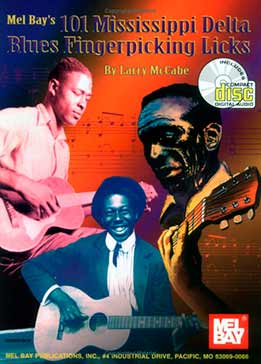101 Mississippi Delta Blues Fingerpicking Licks PDF + MP3 audio tracks Play Along Larry McCabe

Best Sheet Music download from our Library.
Please, subscribe to our Library. Thank you!
Table of Contents:
This book/CD (MP3) set examines four and eight-beat blues licks which may be played within typical chord patterns in the most commonly used blues keys. Written for blues fingerstyle guitar, complete with pima fingering for the classically trained guitarist, the licks vary in difficulty but all lie within the capability of the beginning to intermediate player.
The coarse primitive quality of fingerpicking blues is captured in these 101 licks, harkening back to the roots of blues- the work songs, field hollers, and spirituals of the rural South. Although rooted in the acoustic tradition of the Delta area of northwestern Mississippi, these licks can be played on any six- string guitar in standard tuning.
Veteran Mel Bay author Larry McCabe also provides an introduction to the blues, an extensive guide to symbols used in guitar music in standard notation and tab, ten licks that may be used as introductions or turnarounds and a recommended discography for further listening. The accompanying CD/MP3 includes 99 musical examples to help capture the authentic feel of the music.
Contents:
101 MISSISSIPPI DELTA BLUES FINGERPICKING LICKS. CD TAB.
Introduction
Why folks have the blues
How to use this book
The notation of fingerstyle guitar music
Four-Beat Fingerpicking Blues Licks
Patterns for C
Patterns for G
Patterns for D
Patterns for A
Patterns for E
Patterns for B
Patterns for F
Eight-Beat Fingerpicking Blues Licks
Patterns for C
Patterns for G
Patterns for D
Patterns for A
Patterns for E
Patterns for B
Patterns for F
Introductions and Turnarounds
Key of C
Key of G
Key of D
Key of A
Key of E
DEEP RIVER BLUES | Country Blues Fingerpicking on the Martin DX Johnny Cash Guitar
TUNING: Standard Tuning: E-A-D-G-B-E
In Blues Fingerpicking, you play the rhythm, the chords and the melody all at once. Having no need for amps, pedals or even picks, this style tends to connect people to a simpler time. All you need to play fingerstyle blues are two hands, a guitar and a lot of soul.
The three main components of playing fingerstyle and master them separately. When you have them down, you can combine them into a really cool piece of music that will sound like more than one guitar.
- Bass Line
- Chords
- Melody
Rhythm
There are so many rhythm styles in the blues, from straight quarter notes to shuffle patterns to walking basslines. By far the easiest rhythm to get started with is the straight ahead quarter note thump. Walking basslines baffle me.
Grab your metronome, set it to around 90 bpm and play along with the beats. Use your thumb pluck the open E string on each beat of the metronome, the quarter notes. It helps to count out loud. Tap your foot, bob your head. Get into it.
Though it doesn’t feel like it when you are just playing one note repeatedly, you are establishing the groove. Setting your internal metronome.
Your left hand will feel left out, but we will add some left hand duties once you master the ‘thumb pump’ beat.
What we want to do here is build up the muscles in your thumb. This can take a solid week or two of just practicing this one note over and over again. Getting a solid thumping sound can be very frustrating, but hang in there and you will get it.
Practice this thumb beat over and over until the muscles in your thumb ache and everyone around you wishes that you would “just play a song.”
When you have this nailed, you should be able to thump out the E note in time and carry on a conversation without missing a beat. Once you can do that, you can move on.
Chords
Start by fretting an E major chord then lay your right hand index finger on the G string, your right middle finger on the B string and your right ring finger on the high E string. Then pluck each of these strings simultaneously with a pinching motion.
Essentially you are playing three notes from the E major chord. Keep your thumb going on the quarter notes and count them out loud. As you get to the first beat of the measure, pluck the top three strings of the E major chord and let them ring.
Practice this one bar exercise a good bit. Until you get comfortable with the coordination of the thumb and plucking the chord. When you have this down, move the chord to the second beat of the measure, the third and then the fourth.
When playing on the thumb beat becomes natural, play the chord with your three fingers in between the thumb notes. These would be the eighth notes.
If you count a measure with eighth notes like this: 1 & 2 & 3 & 4 &
The eighth notes would be the &’s.
When you can pluck the chord out on any beat of the measure that you wish, then its time to add some melody lines.
Melody
This is the part of the song that will be stuck in your head long after you have put the guitar down.
Adding a melody line to the thumping thumb and chord rhythm might seem difficult at first, but start with a very simple lead line with only three notes or so and build from there. Most of the ‘licks’ that I play are usually very simple, but they repeat and establish the overall melodic motif of the tune.
These don’t need to be complicated to sound cool. The main thing is that they are in time with the bass and the chords that you are playing.
